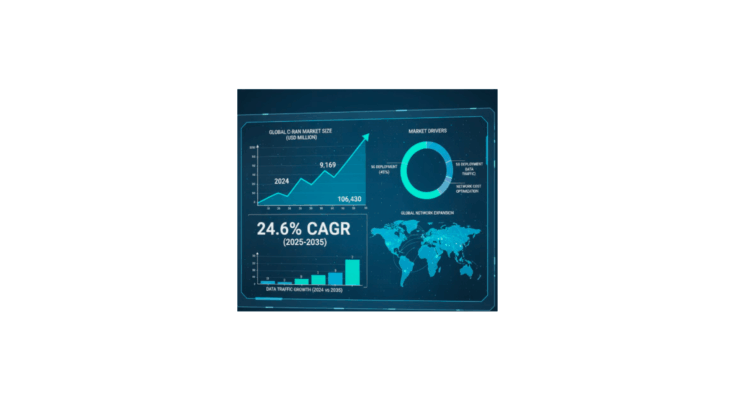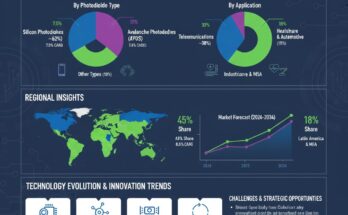The global Cloud Radio Access Network (C-RAN) market is on an unprecedented growth trajectory, projected to reach USD 106,430 million by 2035, up from USD 9,169 million in 2024. This remarkable growth, at a robust CAGR of 24.6% over the forecast period (2025–2035), is being propelled by the convergence of rapid 5G deployment, escalating mobile data traffic, and the pressing need to optimize network costs.
The market’s expansion is being fueled by telecom operators’ strategic investments in centralized and virtualized network architectures. By pooling resources and enabling dynamic spectrum allocation, C-RAN enhances spectral efficiency, reduces total cost of ownership, and provides scalable solutions for the next-generation digital ecosystem.
Government Initiatives and Technological Advancements Driving Market Growth
Increasing mobile data usage, rapid 5G rollouts, and rising demand for cost-effective network solutions are the primary growth drivers for the C-RAN market. Government-backed programs and policy initiatives play a pivotal role in accelerating deployment. For instance, programs promoting smart cities, autonomous vehicles, and industrial IoT are directly contributing to increased investments in centralized RAN infrastructure globally.
Network function virtualization (NFV) and software-defined networking (SDN) have further strengthened C-RAN adoption by enabling operators to enhance network flexibility. Real-time applications such as augmented reality (AR), IoT platforms, and smart urban solutions are increasingly dependent on low-latency, high-throughput connectivity, positioning C-RAN as a strategic imperative in modern telecom networks.
Challenges and Market Restraints
Despite its advantages, the C-RAN market faces challenges. The initial infrastructure investment—including cloud deployment and high-speed fronthaul networks—remains substantial, creating entry barriers for smaller telecom operators. Deployment complexity in heterogeneous networks with legacy systems, interoperability among multi-vendor components, and cybersecurity concerns due to centralized architectures are additional obstacles. Limited fiber infrastructure in underdeveloped regions also restricts large-scale adoption. However, collaborative innovations among technology providers are addressing these challenges, paving the way for broader implementation.
Regional Insights and Market Leadership
North America leads C-RAN adoption, driven by Tier-1 operators such as Verizon, AT&T, and T-Mobile. Early 5G rollouts, high mobile data consumption, and supportive government initiatives create an enabling environment for advanced network deployments.
East Asia, particularly China, Japan, and South Korea, is another major growth hub. China’s rapid deployment of 5G base stations and investments by vendors like Huawei and ZTE have accelerated market expansion. Japan and South Korea leverage C-RAN for urban densification and low-latency industrial applications, including autonomous mobility and smart manufacturing.
Western Europe, led by Germany, France, and the UK, is advancing towards virtualized RAN architectures. Initiatives like Open RAN and public-private partnerships are fostering innovation and accelerating market adoption across the continent.
Country-Level Growth Highlights
-
United States: Driven by massive 5G deployments, network virtualization, and rising mobile data volumes. Government programs, including the Infrastructure Investment and Jobs Act, are funding broadband upgrades that facilitate C-RAN deployment, supporting sectors such as automotive, healthcare, and manufacturing with private 5G networks.
-
China: Backed by the “New Infrastructure” program, China is rapidly expanding C-RAN infrastructure for smart cities, autonomous vehicles, and industrial IoT. Collaboration between telecom operators and cloud providers is accelerating edge-cloud integration and AI-enabled network management.
-
Japan: Emphasizing ultra-reliable low-latency communication (URLLC) and disaster-resilient networks, Japan is deploying C-RAN for smart manufacturing, healthcare, and AI-driven IoT applications. Government-industry cooperation is fostering rapid technological adoption.
Category-Wise Market Outlook
Implementation services are the fastest-growing subsegment, driven by the demand for seamless integration of virtualized RAN components. Operators seek end-to-end deployment support, from network design to optimization, to minimize disruption and accelerate time-to-market.
Cloud-native deployments and urban 5G demand are positioning C-RAN as the fastest-growing technology, enabling cost-efficient, scalable, and centrally managed network infrastructures. Telecom operators are the primary end-users, leveraging C-RAN to modernize networks, manage soaring data traffic, and enhance service quality in densely populated areas.
Competitive Landscape and Strategic Developments
Key players shaping the C-RAN market include Nokia Corporation, Ericsson, Huawei Technologies, ZTE Corporation, Samsung Electronics, NEC Corporation, Altiostar, Fujitsu, Intel Corporation, Mavenir, and Cisco. Strategic collaborations, AI-powered orchestration, multi-vendor interoperability, and cloud-native architectures are enabling competitive differentiation.
Recent developments underscore the industry’s momentum:
-
Nokia (March 2025): Strategic collaboration for AI-RAN deployment, enhancing real-time optimization and energy efficiency in 5G networks.
-
Ericsson (October 2024): Launch of seven new 5G Advanced software products to improve spectrum utilization, energy efficiency, and support XR and time-critical applications.
Methodology and Research Excellence
Fact.MR’s 2025 C-RAN market report synthesizes inputs from over 8,000 stakeholders across 30 countries. The research includes telecom operators, enterprise decision-makers, 5G consultants, and cloud infrastructure engineers. Spanning 13 months, the study employs advanced analytics, time-series forecasting, and scenario simulation to provide precise, actionable market insights.
Market Segmentation
-
By Component: Solutions, Services, Consulting Services, Implementation Services, Support Services
-
By Deployment: Centralized, Cloud RAN
-
By End User: Telecom Operators, Enterprises
-
By Network Type: 5G, 4G, 3G & 2G
-
By Region: North America, Latin America, Western Europe, Eastern Europe, East Asia, South Asia & Pacific, Middle East & Africa
Conclusion
As telecom operators and enterprises seek agile, low-latency, and cost-efficient network solutions, the C-RAN market stands at the forefront of next-generation connectivity. With AI, cloud-native orchestration, and 5G integration, industry leaders have a significant opportunity to capitalize on this high-growth, innovation-driven market.
Browse Full Report : https://www.factmr.com/report/cloud-radio-access-network-market


